2. 重庆市农业资源与环境研究重点实验室, 重庆 400716;
3. 农业部西南耕地保育重点实验室, 重庆 400716
2. Chongqing Key Laboratory of Agricultural Resources and Environment, Chongqing 400716, China;
3. Key Laboratory of Arable Land Conservation for Southwest China, Ministry of Agriculture, Chongqing 400716, China
土壤作为大气CO2的天然碳汇, 其有机碳储量约为1 500 Pg, 高于植物碳库(约550 Pg)和大气碳库(约850 Pg)的总和[1~3].土壤有机碳(SOC)的累积量和周转速率因而显著影响着全球碳收支和气候系统的稳定性[4~6].植物残体是土壤有机碳最重要的来源, 具有不同光合途径的植物在光合作用过程中存在同位素的分馏效应, 从而使植株稳定性碳同位素组成(δ13C)差异较大.研究表明, C3植物的δ13C值介于-20‰ ~-35‰之间, 均值为-27‰; C4植物δ13C值范围为-9‰ ~-17‰, 均值为-13‰[7].因此, 植被凋落物与根系分泌物直接影响着表层土壤的δ13C值.土壤剖面δ13CSOC的分布主要归因于微生物分解有机物时对12C的优先选择, 导致分解底物中13C的富集[8].然而, 土壤性质和气象条件等因素的不同, 可能会影响微生物的分解效率, 进而导致土壤稳定性碳同位素组成不同.
稳定性碳同位素组成能有效反映环境中碳的动态变化, 国内外许多学者常将其用于研究环境中碳的源汇关系, 定量评价碳组分的循环周转, 反演气候变化和人文干扰下土壤的历史变化等[9, 10].例如, Atere等[10]的研究利用δ13CSOC研究了不同施肥制度下水稻土有机碳积累和碳流动途径; Wang等[11]的研究通过碳同位素质量平衡模型和文献荟萃分析验证了δ13CSOC与土壤有机碳周转之间的关系; Li等[12]的研究利用δ13CSOC揭示了青藏高原东北部冰丘土壤有机碳的动态变化.然而, 土壤稳定性碳同位素组成是多种因素共同作用下的结果, 其分布可能随研究区域和空间尺度的变化而变化[13~16].有研究表明, 东北典型漫岗坡耕地表层土壤δ13C值与地形坡度、土壤黏粒含量和pH都显著相关[17]; 阿拉尔绿洲δ13CSOC受土壤类型和土壤含水量的影响最甚[4]; 阿根廷南部的森林生态系统δ13CSOC的控制因素是年均降雨量, 而不是土壤性质[18]; 气温和SOC则是高寒地区δ13CSOC的控制因素[11].
目前, 土壤有机碳稳定性同位素组成在碳循环研究中的应用在日益增加[19, 20], 但由于同位素分析仪器精密贵重, 分析成本高, 故其在大尺度空间下分布的基础数据仍极为匮乏, 影响了人们对其的深入探讨.因此, 本研究以重庆地区农田为研究对象, 拟通过对采自182个典型剖面的546个土壤样品有机碳δ13C值的测定, 探讨不同土壤层次、耕作制度、作物和土壤类型下有机碳稳定性同位素组成的差异和影响因素, 从多个角度揭示重庆农田土壤有机碳稳定性同位素的空间分布特征, 以期为未来缓解气候变化、农业土壤碳汇管理和实施碳中和战略提供科学基础.
1 材料与方法 1.1 研究区概况重庆位于中国西南部的长江上游地区, 地跨东经105°11′~110°11′、北纬28°10′~32°13′, 总体地势为东南部和东北部高、中部和西部低, 东部海拔一般在1 000~2 796 m之间, 西部海拔在168~900 m之间, 形成了西部丘陵、中部平行岭谷和东部中低山为主的地貌组合.区域山地占76%, 丘陵占22%, 河谷平坝仅占2%.重庆属亚热带季风性湿润气候, 年均气温为15~18℃, 常年降雨量为1 000~1 450 mm, 年均相对湿度接近80%, 属高湿区.由于复杂的地质地貌条件, 加上区域内气候和生物等成土因素具有明显的垂直变化和空间差异, 土壤多样, 分布较广的主要有黄壤、紫色土、水稻土、石灰(岩)土和潮土.全市耕地面积为237.05万hm2, 是重庆第二大土地利用类型, 主要耕作制度为旱作、水田和水旱轮作, 主要种植水稻、玉米、油菜和烟叶等粮食与经济作物.按传统习惯, 可将重庆分为渝西(北碚、璧山、大足、合川、江津、南川、綦江、荣昌、铜梁、永川、潼南和万盛)、渝中(巴南、长寿、涪陵、九龙坡、沙坪坝和渝北)、渝东北(城口、垫江、奉节、开县、梁平、万州、忠县、巫溪、巫山和云阳)和渝东南(丰都、彭水、石柱和武隆).
1.2 样品采集以土壤类型分布面积比例为基础, 选择远离工业区和城区的典型农田作为样地(图 1).于2016年7~8月间农作物收获后人工挖掘土壤剖面, 按表层(0~30 cm)、中层(30~60 cm) 和底层(60~100 cm)进行分层采样.每个剖面同一层次、不同位置分别采集4个样品后归并为该层混合样.每块样地近20年来的耕作制度和作物种植历史则通过向农户口头询问获取.本研究共计182块样地(土壤剖面), 546个土样.样地按土壤类型分, 包括紫色土68块、水稻土53块、石灰(岩)土21块、黄壤23块和潮土17块; 按作物类型分, 长期种植C3作物的72块、C4作物12块、C3和C4混种的98块.
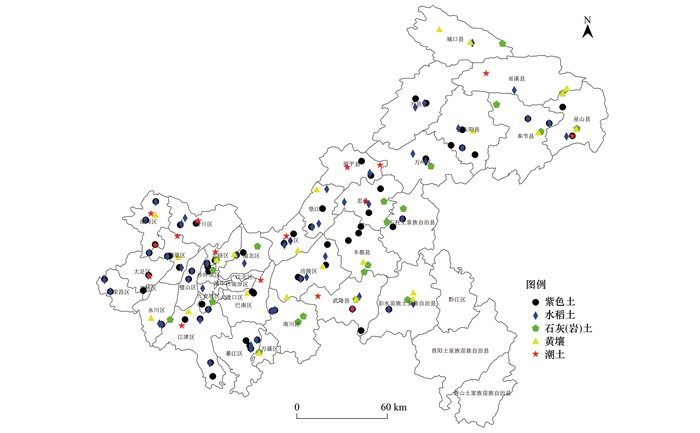
|
图 1 重庆农田采样点分布示意 Fig. 1 Distribution map of farmland sampling sites in Chongqing |
采样点的经纬度和海拔高度信息由GPS仪采集记录, 年均气温和年均降雨量由覆盖研究区域的59个气象站点的多年(1986~2015年)均值数据经克里格插值后提取获得.
1.4 土样测定采集的土壤经自然风干后除去石砾和动植物残体等杂质, 按四分法取样, 依次研磨制备过10和200目筛的样品.
称取过10目筛的土样测定pH值(1 ∶5土水比, 雷磁PHS-3E型).对于pH>6.5的土壤, 称取0.500 g过200目筛的样品, 加入过量2 mol·L-1的盐酸, 反应6 h以去除土壤中的碳酸盐, 然后用去离子水洗涤至中性, 低温烘干重新磨细后用于SOC含量和同位素组成分析; 至于pH<6.5的土样则不经过盐酸处理, 直接称样测定[21].土样SOC、TN和稳定性碳同位素比均用元素分析仪——连续流同位素比质谱联用系统测定(农业部西南耕地保育重点实验室, Vario Pyro Cube-IsoPrime 100 system).
稳定性碳同位素比的表示方法: δ13C值表示样品中两种碳同位素比值相对于某一标准对应比值的相对千分差, 是描述样品与标准样品相比较时, δ13C天然丰度变异程度的指标, 其计算公式为:

|
式中,标准选用美国南卡罗莱纳州白垩系皮狄组地层中的美洲拟箭石(PDB), 其13C/12C=0.011 237 2[22].
1.5 统计分析统计分析皆利用SPSS 22.0软件完成.利用单因素方差分析(One-way ANOVA)结合多重比较法(LSD)对土壤剖面不同层次间或不同耕作制度、作物和土壤类型等变量的均值差异性进行比较(显著性水平为0.05).为避免自变量之间的多重线性问题, 土壤pH、TN、气象条件(气温和降雨量)、SOC、海拔、作物类型和土壤类型等因素对表、中和底层土壤δ13C值的影响用回归树(regression tree)进行分析.这种方法是通过递归方式构建二叉决策树, 并经过剪枝形成优化模型的过程.其优点是结果透明, 便于评估自变量的相对重要性[23].
2 结果与分析 2.1 SOC及其δ13C分布概况由表 1可知, 重庆农田剖面土壤δ13CSOC范围从上至下分别为-26.81‰ ~-19.25‰、-26.23‰ ~-18.78‰和-26.15‰ ~-15.36‰, 平均值分别为(-23.63±1.53)‰、(-22.43±1.59)‰和(-21.42±1.90)‰, δ13CSOC值随土壤深度增加而逐渐趋正; 表、中和底层ω(SOC)均值分别为(8.69±3.84)、(4.96±2.57)和(3.19±1.81) g·kg-1, SOC含量随土壤深度增加而减少.
|
|
表 1 重庆农田土壤基本情况1) Table 1 Basic situation of farmland soil in Chongqing |
图 2为重庆农田SOC及其δ13C值的区域分布.就区域而言, δ13CSOC值整体表现为渝东北<渝西<渝东南<渝中.渝中地区土壤表、中和底层δ13CSOC范围分别为-26.19‰ ~-19.25‰、-25.53‰ ~-17.87‰和-25.38‰ ~-16.30‰, 平均值分别为(-22.97±1.65)‰、(-21.68±1.79)‰和(-20.59±2.26)‰; 渝西剖面从上至下δ13CSOC范围分别为-26.42‰ ~-20.41‰、-26.23‰ ~-19.65‰和-26.15‰ ~-15.36‰, 平均值分别比渝中同层次偏负0.86‰、1.02‰和0.97‰; 渝东北剖面从上至下δ13CSOC范围分别为-26.63‰ ~-20.97‰、-25.87‰ ~-18.78‰和-24.89‰ ~-17.07‰, 平均值分别比渝中同层次偏负0.96‰、1.04‰和1.29‰.
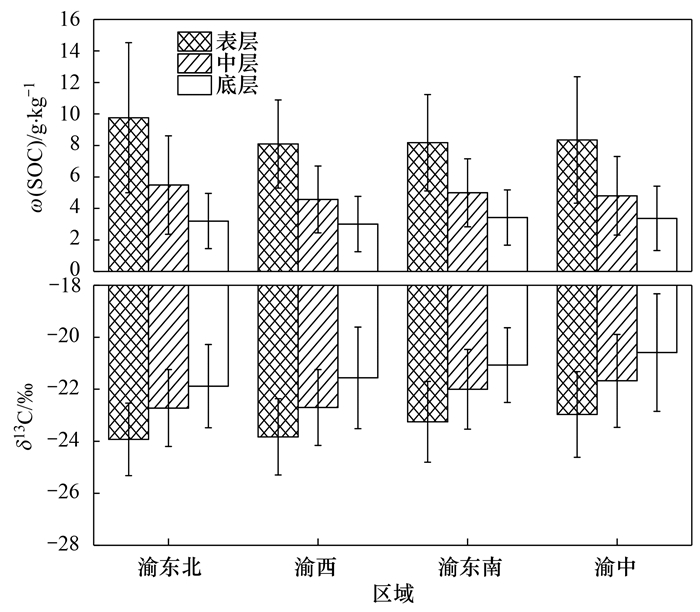
|
图 2 重庆农田SOC及其δ13C值的区域分布 Fig. 2 Regional distribution of soil organic carbon and its δ13C value in Chongqing |
如图 3所示, 水田剖面ω(SOC)最高, 表、中和底层平均值分别为(9.88±1.49)、(5.99±2.12)和(3.55±1.93) g·kg-1, 旱地SOC含量最低, 各层分别比水田低15%、21%和14%, 水旱轮作则居于两者之间.
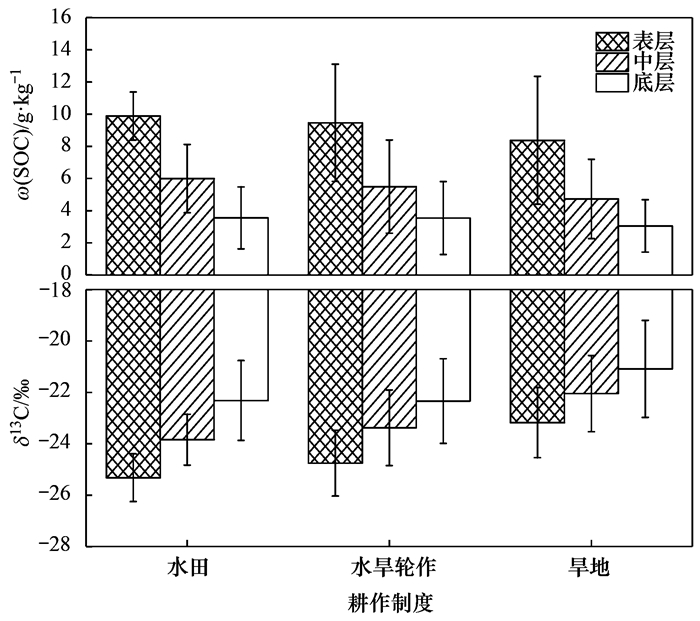
|
图 3 不同耕作制度下SOC及其δ13C值的分布特征 Fig. 3 Distribution characteristics of soil organic carbon and its δ13C value in different farming systems |
如图 3所示, 表层和中层土壤δ13C值由负趋正且表现为: 水田<水旱轮作<旱地; 底层土壤δ13C值由负趋正, 依序为: 水旱轮作<水田<旱地, 整体表现出旱地明显偏正.就表层而言, 旱地、水旱轮作和水田δ13CSOC值范围分别为-26.54‰ ~-19.25‰、-26.81‰ ~-21.75‰和-26.23‰ ~-23.87‰, 平均值分别为(-23.17±1.37)‰、(-24.75±1.28)‰和(-25.32±0.93)‰, 水旱轮作和水田表层δ13CSOC值分别比旱地表层偏负1.58‰、2.15‰.
2.3 不同作物类型下δ13CSOC值的差异图 4为不同作物类型下SOC及其δ13C值的分布.从中可知, 表层SOC含量表现为: C3>C3和C4混种>C4; 中层和底层SOC含量均表现为: C3>C4>C3和C4混种.就表层而言, 种植C3作物的ω(SOC)在2.23~23.18 g·kg-1之间, 平均值为(9.35±3.59) g·kg-1; 种植C4作物的ω(SOC)在3.50~11.26 g·kg-1之间, 平均值为(7.18±2.03) g·kg-1.

|
图 4 不同作物类型下SOC及其δ13C值的分布特征 Fig. 4 Distribution characteristics of soil organic carbon and its δ13C value in different crop types |
如图 4所示, 剖面δ13CSOC值由负趋正且表现为: C3<C3和C4混种<C4.以表层为例, 种植C3作物的土壤δ13C值在-26.81‰ ~-21.35‰之间, 平均值为(-24.56±1.26)‰; 种植C4作物的在-24.32‰ ~-20.53‰之间, 平均值比C3作物偏正2.03‰; C3和C4混种的在-26.54‰ ~-19.25‰之间, 平均值比C3作物偏正1.49‰.
2.4 不同土壤类型下δ13CSOC值的差异不同土壤类型下, SOC及其δ13C值的分布情况如图 5所示. SOC含量整体表现为: 石灰(岩)土>水稻土>黄壤>潮土>紫色土, 石灰(岩)土ω(SOC)最高, 其表层最为明显, 平均值为(12.23±4.49) g·kg-1, 是紫色土表层的1.79倍.

|
图 5 不同土壤类型下SOC及其δ13C值的分布特征 Fig. 5 Distribution characteristics of soil organic carbon and its δ13C value in different soil types |
如图 5所示, 表层土壤δ13CSOC值由负趋正的次序为: 水稻土<潮土<紫色土<石灰(岩)土<黄壤, 中层依序为: 水稻土<潮土<石灰(岩)土<紫色土<黄壤, 底层则为: 水稻土<石灰(岩)土<潮土<紫色土<黄壤.其中, 水稻土表层土壤δ13C均值为(-24.77±1.23)‰, Δδ13C(即底层与表层土壤δ13C之差值)平均值为2.46‰; 紫色土表层土壤δ13C均值为(-23.20±1.29)‰, Δδ13C平均值为2.30‰; 而黄壤δ13C值总体上在所有土壤中最高, 其表层均值为(-22.61±1.29)‰, Δδ13C平均值为2.11‰.整体表现出黄壤和紫色土δ13CSOC偏正程度高于水稻土.
2.5 回归树回归树分析表明, 作物、土壤类型、TN、海拔和pH皆可影响表层土壤的δ13CSOC值, 其中作物类型是首要因素(图 6).当种植作物为C3类型, 土壤类型为潮土或水稻土, 且海拔>273m时, δ13CSOC值偏负程度最高, 均值为(-25.13±0.96)‰; 当作物为C4或C3和C4作物混种, 且TN≤0.80 g·kg-1时, δ13CSOC值偏正程度最高, 为(-21.82±1.35)‰.
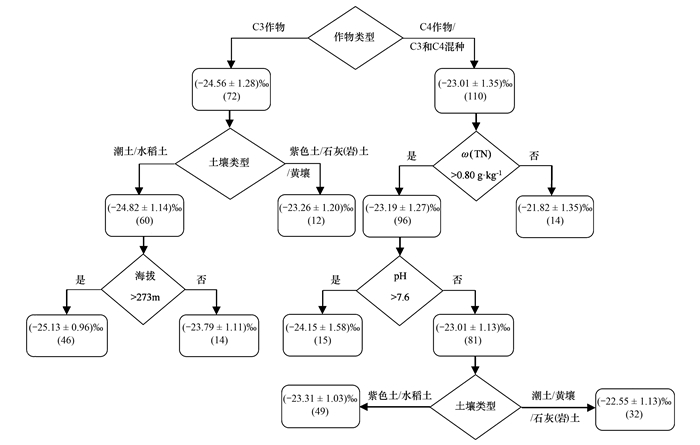
|
δ13CSOC值为“mean±SD”, 括号中为样本数, 下同 图 6 表层土壤δ13C值回归树 Fig. 6 Regression tree for top-layer soils |
与表层土壤不同, 中层土壤δ13CSOC值的主控因素为土壤类型, 其他因素如TN、降雨量和海拔也发挥着重要作用(图 7). 当潮土或水稻土的ω(TN)>0.89 g·kg-1, 且年均降雨量>1 111.0 mm时, δ13CSOC值偏负, 为(-24.54±0.82)‰; 当土壤类型为紫色土、黄壤或石灰(岩)土, 降雨量介于1 053.5~1 162.5 mm, ω(TN) ≤ 0.89 g·kg-1, 且海拔≤359.5 m时, δ13CSOC偏正, 其值为(-19.95±1.28)‰, 比最负值偏负4.59‰.
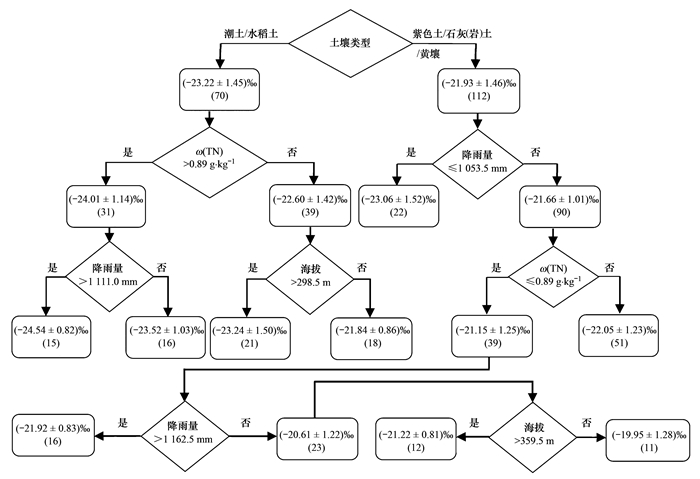
|
图 7 中层土壤δ13C值回归树 Fig. 7 Regression tree for middle-layer soils |
对于底层土壤δ13CSOC值的主控因素仍然是土壤类型, 气温、SOC和pH则为次要因素(图 8).当土壤类型为石灰(岩)土或水稻土, ω(SOC)>6.26 g·kg-1时, δ13CSOC值偏负, 均值为(-23.88±1.20)‰; 当土壤类型为紫色土、黄壤或潮土, 气温>17.6℃, ω(SOC)≤2.47 g·kg-1时, δ13CSOC值偏正程度最高, 比最负值偏负4.98‰.
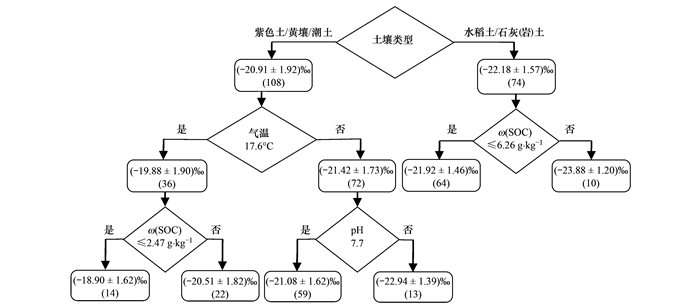
|
图 8 底层土壤δ13C值回归树 Fig. 8 Regression tree for bottom-layer soils |
重庆农田表层土壤δ13C平均值为-23.63‰, 偏负于华北平原地区高产农田(表层为-21‰左右)[10]和东北松花江流域坡耕地(表层为-19‰左右)[17], 偏正于广东省西南部森林土壤(表层为-27.31‰)[24]; 中层和底层土壤的δ13C平均值分别为-22.43‰和-21.42‰.与已有的研究结果一样[25~28], 本研究也发现δ13CSOC值均随土壤深度加深而趋正.这可能与土壤表层有机碳向下淋溶迁移过程中, 发生的有机碳分解转化和同位素分馏作用有关[29].在SOC分解过程中, 微生物倾向于利用较轻的12C组分, 13C重组分则在分解底物中得以积累[19], 故δ13CSOC值随剖面加深逐渐趋正.除此之外, Suess效应也可能发挥了重要作用, 即化石燃料的燃烧导致大气CO2的δ13C值比200年前偏负了约1.99‰, 使得地表植被δ13C也随着偏负, 从而导致土壤上层新输入有机碳δ13C值与下层古老有机碳δ13C值相比更加趋负[21].
就重庆不同区域而言, 渝中δ13CSOC值偏正, 渝西和渝东北则偏负.渝中地区海拔较低, 气温较高, 且为重庆主要社会经济活动区域, 土地集约化程度较高[30], 导致有机质循环周转速度较快, 因此δ13CSOC值整体表现为偏正.渝西地区广泛分布着稻田, 水田样品采集多源于此区域.有研究表明, 水田有机碳周转速度低于旱地, 具有更高的有机碳储量和封存潜力[31, 32], 故δ13CSOC值较偏负.渝东北属于高海拔地区, 气温较低且降雨量较大, 制约着有机碳的循环周转[33], 而环境中分布的植物大多为C3类型, 因此土壤δ13C值整体偏负.
3.2 环境因子对δ13CSOC组成的影响通过回归树分析, 本研究发现不同土层的影响因素重要性排序和划分阈值均有差异.表层土壤(图 6)的首要影响因素为作物类型, 中层(图 7)和底层(图 8)均为土壤类型, 这一结果与Jia等[34]的研究结果相似.作物类型是控制表层δ13CSOC值最重要的环境变量, 其凋落物和根系分泌物直接影响着表层土壤δ13C值, 这归因于植物本身的δ13C值差异, C3植物δ13C值较C4相比更趋向负值, 因此种植C3作物的土壤表层δ13C值更趋负[8, 34].当种植作物为C3类型时, 海拔较高的潮土和水稻土的δ13CSOC值更趋负值.这可能是由于海拔越高, 气温越低, 降雨量越大, 导致土壤中有机碳分解速率降低[33].此外, 潮土和水稻土均具有较高的含水率, 抑制着大多数微生物的活性[4, 35].
然而, 在中层和底层中, 土壤类型则为最主要的控制因素, 土壤类型的影响可能与有机质分解过程中同位素分馏有关, 不同土壤类型间微生物群落组成和理化性质有很大差异, 这就导致有机质在不同土壤环境中的分解速度和分解程度差异显著[36].中层和底层土壤的主控因素虽均为土壤类型, 但具体划分也有所差异.中层土壤中, 潮土和水稻土的δ13CSOC值偏负, 而底层则将石灰(岩)土和水稻土划分为一类.这可能由于石灰(岩)土剖面有机碳同位素组成随土壤深度加深变化轻微, 底层与表层之差仅为1.28‰(图 5), 因此随着其他类型土壤同位素分馏效应的增强, 石灰(岩)土底层δ13CSOC值则较偏负, 已有研究发现了同样的规律[37~40].
除了作物类型和土壤类型等主要因素的影响, 土壤δ13C值还受TN、pH、海拔、气温和降雨量的影响(图 6~8).氮是控制陆地生态系统的关键元素之一, 较高的氮含量通过影响微生物活动, 从而影响SOC循环周转速度, 利于有机碳的积累, 导致δ13CSOC值更趋负[41, 42].有研究表明, 弱酸环境有助于土壤微生物群落多样性的提高, 随着微生物活动增强, SOC分解速率加快, 使δ13CSOC值更趋正[43, 44].此外, 海拔的变化也会造成气候(气温和降雨量)的差异, 从而影响SOC的矿化速率和植被的分布与生长. Papatheodorou等[45]的研究发现气温的升高会增加微生物种类、数量和活性, 从而在一定程度上加速12C的分解, 导致13C的富集.
4 结论(1) 重庆农田所有剖面δ13CSOC值随深度加深逐渐趋正, 表、中和底层均值分别为(-23.63±1.53)‰、(-22.43±1.59)‰和(-21.42±1.90)‰.其中, 渝东北δ13CSOC值偏负程度最高, 渝中δ13CSOC值偏正程度最高.
(2) 不同耕作制度下, 旱地δ13CSOC值明显偏正, 水田偏负, 水旱轮作则居于两者之间, 三者表层土壤δ13C均值分别为(-23.17±1.37)‰、(-25.32±0.93)‰和(-24.75±1.28)‰.与种植C4及C3、C4作物混种相比, 种植C3作物的土壤δ13CSOC值明显偏负; 不同类型土壤表层δ13CSOC值依序为: 水稻土<潮土<紫色土<石灰(岩)土<黄壤.
(3) 影响土壤有机碳稳定性碳同位素空间分布的主控因素有作物类型、土壤类型、TN、海拔、pH、气温和降雨量, 其中关键因素为作物类型(表层)和土壤类型(中层和底层).
| [1] | Snæbjörnsdóttir S Ó, Sigfússon B, Marieni C, et al. Carbon dioxide storage through mineral carbonation[J]. Nature Reviews Earth & Environment, 2020, 1(2): 90-102. |
| [2] | Kumar R, Pandey S, Pandey A. Plant roots and carbon sequestration[J]. Current Science, 2006, 91(7): 885-890. |
| [3] | Kopittke P M, Dalal R C, Hoeschen C, et al. Soil organic matter is stabilized by organo-mineral associations through two key processes: the role of the carbon to nitrogen ratio[J]. Geoderma, 2020, 357. DOI:10.1016/j.geoderma.2019.113974 |
| [4] |
陈新, 贡璐, 李杨梅, 等. 典型绿洲不同土壤类型有机碳含量及其稳定碳同位素分布特征[J]. 环境科学, 2018, 39(10): 4735-4743. Chen X, Gong L, Li Y M, et al. Spatial variation of soil organic carbon and stable isotopes in different soil types of a typical oasis[J]. Environmental Science, 2018, 39(10): 4735-4743. |
| [5] | Lamb A, Green R, Bateman I, et al. The potential for land sparing to offset greenhouse gas emissions from agriculture[J]. Nature Climate Change, 2016, 6(5): 488-492. DOI:10.1038/nclimate2910 |
| [6] | Kirschbaum M U F. Will changes in soil organic carbon act as a positive or negative feedback on global warming?[J]. Biogeochemistry, 2000, 48(1): 21-51. DOI:10.1023/A:1006238902976 |
| [7] |
张月鲜, 李素艳, 孙向阳, 等. 荒漠草原土壤有机质碳稳定同位素特征研究[J]. 水土保持学报, 2011, 25(3): 164-168. Zhang Y X, Li S Y, Sun X Y, et al. Research on characteristics of soil stable carbon isotope composition in desertification grassland[J]. Journal of Soil and Water Conservation, 2011, 25(3): 164-168. |
| [8] |
张昊, 李建平. 稳定碳同位素在草地生态系统碳循环中的应用与展望[J]. 水土保持研究, 2021, 28(1): 394-400. Zhang H, Li J P. Application and prospect of stable carbon isotope to the study of carbon cycle in grassland ecosystem[J]. Research of Soil and Water Conservation, 2021, 28(1): 394-400. |
| [9] | Guo Q J, Zhu G X, Chen T B, et al. Spatial variation and environmental assessment of soil organic carbon isotopes for tracing sources in a typical contaminated site[J]. Journal of Geochemical Exploration, 2017, 175: 11-17. DOI:10.1016/j.gexplo.2016.12.009 |
| [10] | Atere C T, Gunina A, Zhu Z K, et al. Organic matter stabilization in aggregates and density fractions in paddy soil depending on long-term fertilization: tracing of pathways by 13C natural abundance[J]. Soil Biology and Biochemistry, 2020, 149. DOI:10.1016/J.SOILBIO.2020.107931 |
| [11] | Wang C, Wei H W, Liu D W, et al. Depth profiles of soil carbon isotopes along a semi-arid grassland transect in northern China[J]. Plant and Soil, 2017, 417(1-2): 43-52. DOI:10.1007/s11104-017-3233-x |
| [12] | Li H Z, Yan F, Tuo D F, et al. The effect of climatic and edaphic factors on soil organic carbon turnover in hummocks based on δ13C on the Qinghai-Tibet Plateau[J]. Science of the Total Environment, 2020, 741. DOI:10.1016/j.scitotenv.2020.140141 |
| [13] |
孟凡乔, 匡星, 杜章留, 等. 不同土地利用方式及栽培措施对土壤有机碳及δ13C值的影响[J]. 环境科学, 2010, 31(8): 1733-1739. Meng F Q, Kuang X, Du Z L, et al. Impact of land use change and cultivation measures on soil organic carbon (SOC) and its 13C values[J]. Environmental Science, 2010, 31(8): 1733-1739. |
| [14] | Dou X L, He P, Cheng X L, et al. Long-term fertilization alters chemically-separated soil organic carbon pools: Based on stable C isotope analyses[J]. Scientific Reports, 2016, 6(1). DOI:10.1038/srep19061 |
| [15] | Andriollo D D, Redin C G, Reichert J M, et al. Soil carbon isotope ratios in forest-grassland toposequences to identify vegetation changes in southern Brazilian grasslands[J]. CATENA, 2017, 159: 126-135. DOI:10.1016/j.catena.2017.08.012 |
| [16] | Liu Y, Liu W Z, Wu L H, et al. Soil aggregate-associated organic carbon dynamics subjected to different types of land use: evidence from 13C natural abundance[J]. Ecological Engineering, 2018, 122: 295-302. DOI:10.1016/j.ecoleng.2018.08.018 |
| [17] |
方华军, 杨学明, 张晓平, 等. 坡耕地黑土剖面有机碳的分布和δ13C值研究[J]. 土壤学报, 2005, 42(6): 957-964. Fang H J, Yang X M, Zhang X P, et al. Profile distribution of organic carbon and δ13C in a black soil at a sloping field[J]. Acta Pedologica Sinica, 2005, 42(6): 957-964. DOI:10.3321/j.issn:0564-3929.2005.06.012 |
| [18] | Peri P L, Ladd B, Pepper D A, et al. Carbon (δ13C) and nitrogen (δ15N) stable isotope composition in plant and soil in Southern Patagonia's native forests[J]. Global Change Biology, 2012, 18(1): 311-321. DOI:10.1111/j.1365-2486.2011.02494.x |
| [19] | Li L D, Schaeffer S M. Stabilization mechanisms of isotope-labeled carbon substrates in soil under moisture pulses and conservation agricultural management[J]. Geoderma, 2020, 380. DOI:10.1016/j.geoderma.2020.114677 |
| [20] |
金鑫鑫, 汪景宽, 孙良杰, 等. 稳定13C同位素示踪技术在农田土壤碳循环和团聚体固碳研究中的应用进展[J]. 土壤, 2017, 49(2): 217-224. Jin X X, Wang J K, Sun L J, et al. Progress of carbon cycle in farmland and sequestration in soil aggregates revealed by stable 13C isotope[J]. Soils, 2017, 49(2): 217-224. |
| [21] | Zhao Q, Poulson S R, Obrist D, et al. Iron-bound organic carbon in forest soils: quantification and characterization[J]. Biogeosciences, 2016, 13(16): 4777-4788. DOI:10.5194/bg-13-4777-2016 |
| [22] |
朱书法, 刘丛强, 陶发祥. δ13C方法在土壤有机质研究中的应用[J]. 土壤学报, 2005, 42(3): 495-503. Zhu S F, Liu C Q, Tao F X. Use of δ13C method in studying soil organic matter[J]. Acta Pedologica Sinica, 2005, 42(3): 495-503. DOI:10.3321/j.issn:0564-3929.2005.03.022 |
| [23] | Melling L, Hatano R, Goh K J. Methane fluxes from three ecosystems in tropical peatland of Sarawak, Malaysia[J]. Soil Biology and Biochemistry, 2005, 37(8): 1445-1453. DOI:10.1016/j.soilbio.2005.01.001 |
| [24] | Xiong X, Zhang H L, Deng Q, et al. Soil organic carbon turnover following forest restoration in south China: evidence from stable carbon isotopes[J]. Forest Ecology and Management, 2020, 462. DOI:10.1016/j.foreco.2020.117988 |
| [25] |
李杨梅, 贡璐, 安申群, 等. 基于稳定碳同位素技术的干旱区绿洲土壤有机碳向无机碳的转移[J]. 环境科学, 2018, 39(8): 3867-3875. Li Y M, Gong L, An S Q, et al. Transfer of soil organic carbon to inorganic carbon in arid oasis based on stable carbon isotope technique[J]. Environmental Science, 2018, 39(8): 3867-3875. |
| [26] |
潘蕊蕊, 李小雁, 胡广荣, 等. 青海湖流域季节性冻土区坡面土壤有机碳分布特征及其影响因素[J]. 生态学报, 2020, 40(18): 6374-6384. Pan R R, Li X Y, Hu G R, et al. Characteristics of soil organic carbon distribution and its controlling factors on hillslope in seasonal frozen area of Qinghai Lake Basin[J]. Acta Ecologica Sinica, 2020, 40(18): 6374-6384. |
| [27] | Deng L, Wang K B, Tang Z S, et al. Soil organic carbon dynamics following natural vegetation restoration: evidence from stable carbon isotopes (δ13C)[J]. Agriculture, Ecosystems & Environment, 2016, 221: 235-244. |
| [28] | Kohl L, Laganière J, Edwards K A, et al. Distinct fungal and bacterial δ13C signatures as potential drivers of increasing δ13C of soil organic matter with depth[J]. Biogeochemistry, 2015, 124(1): 13-26. |
| [29] | Blaser M, Conrad R. Stable carbon isotope fractionation as tracer of carbon cycling in anoxic soil ecosystems[J]. Current Opinion in Biotechnology, 2016, 41: 122-129. DOI:10.1016/j.copbio.2016.07.001 |
| [30] |
叶忠杰. 重庆市主城区及区域中心城市土地集约利用时空差异研究[D]. 重庆: 西南大学, 2011. Ye Z J. Study on temporal-spatial differences of urban land intensive use in Chongqing main districts and regional center[D]. Chongqing: Southwest University, 2011. |
| [31] | Tang H Y, Liu Y, Li X M, et al. Carbon sequestration of cropland and paddy soils in China: potential, driving factors, and mechanisms[J]. Greenhouse Gases: Science and Technology, 2019, 9(5): 872-885. DOI:10.1002/ghg.1901 |
| [32] | Pan G X, Li L Q, Wu L S, et al. Storage and sequestration potential of topsoil organic carbon in China's paddy soils[J]. Global Change Biology, 2004, 10(1): 79-92. DOI:10.1111/j.1365-2486.2003.00717.x |
| [33] |
罗梅, 郭龙, 张海涛, 等. 基于环境变量的中国土壤有机碳空间分布特征[J]. 土壤学报, 2020, 57(1): 48-59. Luo M, Guo L, Zhang H T, et al. Characterization of spatial distribution of soil organic carbon in China based on environmental variables[J]. Acta Pedologica Sinica, 2020, 57(1): 48-59. |
| [34] | Jia Y F, Wang G A, Tan Q Q, et al. Temperature exerts no influence on organic matter δ13C of surface soil along the 400 mm isopleth of mean annual precipitation in China[J]. Biogeosciences, 2016, 13(17): 5057-5064. DOI:10.5194/bg-13-5057-2016 |
| [35] |
熊子怡, 郑杰炳, 王丹, 等. 不同施肥条件下紫色土旱坡地可溶性有机碳流失特征[J]. 环境科学, 2021, 42(2): 967-976. Xiong Z Y, Zheng J B, Wang D, et al. Characteristics of dissolved organic carbon loss in purple soil sloping fields with different fertilization treatments[J]. Environmental Science, 2021, 42(2): 967-976. DOI:10.3969/j.issn.1000-6923.2021.02.051 |
| [36] | Gonçalves D R P, de Moraes Sá J C, Mishra U, et al. Soil type and texture impacts on soil organic carbon storage in a sub-tropical agro-ecosystem[J]. Geoderma, 2017, 286: 88-97. DOI:10.1016/j.geoderma.2016.10.021 |
| [37] |
朱书法, 刘丛强, 陶发祥, 等. 贵州喀斯特地区棕色石灰土与黄壤有机质剖面分布及稳定碳同位素组成差异[J]. 土壤学报, 2007, 44(1): 169-173. Zhu S F, Liu C Q, Tao F X, et al. Difference in stable carbon isotope composition and profile distribution of soil organic matter between brown limestone soil and yellow soil in Karst Areas of Guizhou province[J]. Acta Pedologica Sinica, 2007, 44(1): 169-173. DOI:10.3321/j.issn:0564-3929.2007.01.025 |
| [38] |
李龙波, 刘涛泽, 李晓东, 等. 贵州喀斯特地区典型土壤有机碳垂直分布特征及其同位素组成[J]. 生态学杂志, 2012, 31(2): 241-247. Li L B, Liu T Z, Li X D, et al. Vertical distribution patterns of organic carbon and its isotopic composition in typical soil types in Guizhou karst areas of Southwest China[J]. Chinese Journal of Ecology, 2012, 31(2): 241-247. |
| [39] | Kaiser M, Walter K, Ellerbrock R H, et al. Effects of land use and mineral characteristics on the organic carbon content, and the amount and composition of Na‐pyrophosphate‐soluble organic matter, in subsurface soils[J]. European Journal of Soil Science, 2011, 62(2): 226-236. DOI:10.1111/j.1365-2389.2010.01340.x |
| [40] | Yang L Q, Luo P, Wen L, et al. Soil organic carbon accumulation during post-agricultural succession in a karst area, southwest China[J]. Scientific Reports, 2016, 6(1). DOI:10.1038/srep37118 |
| [41] | Zhao L, Wu X D, Wang Z W, et al. Soil organic carbon and total nitrogen pools in permafrost zones of the Qinghai-Tibetan Plateau[J]. Scientific Reports, 2018, 8(1). DOI:10.1038/s41598-018-22024-2 |
| [42] | Shi H J, Wang X J, Xu M G, et al. Characteristics of soil C∶N ratio and δ13C in wheat-maize cropping system of the North China Plain and influences of the Yellow River[J]. Scientific Reports, 2017, 7(1). DOI:10.1038/s41598-017-17060-3 |
| [43] |
程锦萍, 王鹭, 唐志珍, 等. 模拟酸雨对我国亚热带森林土壤有机碳矿化的影响研究[J/OL]. 农业资源与环境学报: 1-11, https://kns.cnki.net/kcms/detail/detail.aspx?doi=10.13254/j.jare.2021.0093. Cheng J P, Wang L, Tang Z Z, et al. Effects of simulated acid rain on soil organic carbon mineralization in the subtropical forests of China[J/OL]. Journal of Agricultural Resources and Environment: 1-11, https://kns.cnki.net/kcms/detail/detail.aspx?doi=10.13254/j.jare.2021.0093. |
| [44] |
王楠, 潘小承, 白尚斌. 模拟酸雨对我国亚热带毛竹林土壤呼吸及微生物多样性的影响[J]. 生态学报, 2020, 40(10): 3420-3430. Wang N, Pan X C, Bai S B. Effects of simulated acid rain on soil respiration and microbial diversity in Moso bamboo forest in subtropical China[J]. Acta Ecologica Sinica, 2020, 40(10): 3420-3430. |
| [45] | Papatheodorou E M, Argyropoulou M D, Stamou G P. The effects of large- and small-scale differences in soil temperature and moisture on bacterial functional diversity and the community of bacterivorous nematodes[J]. Applied Soil Ecology, 2004, 25(1): 37-49. DOI:10.1016/S0929-1393(03)00100-8 |
 2022, Vol. 43
2022, Vol. 43


